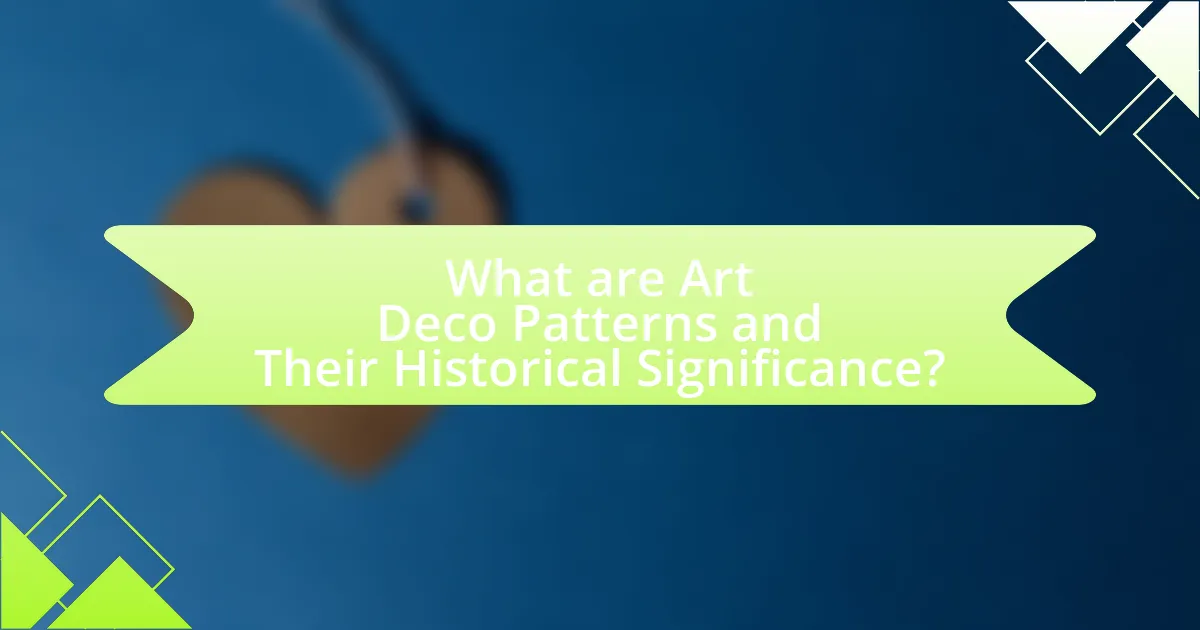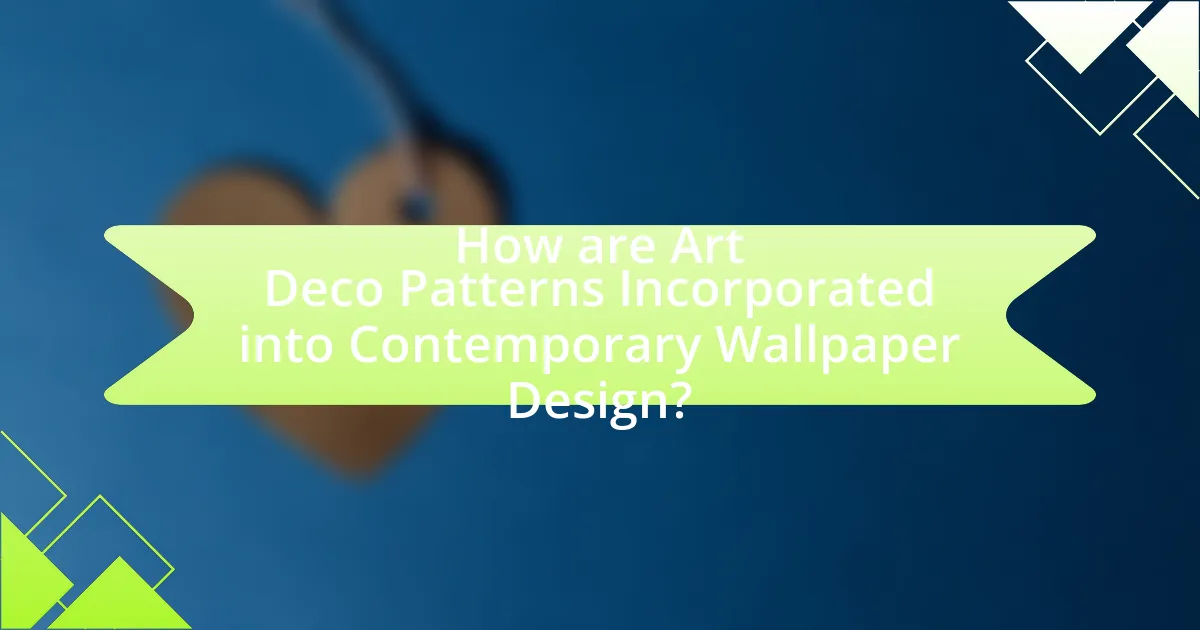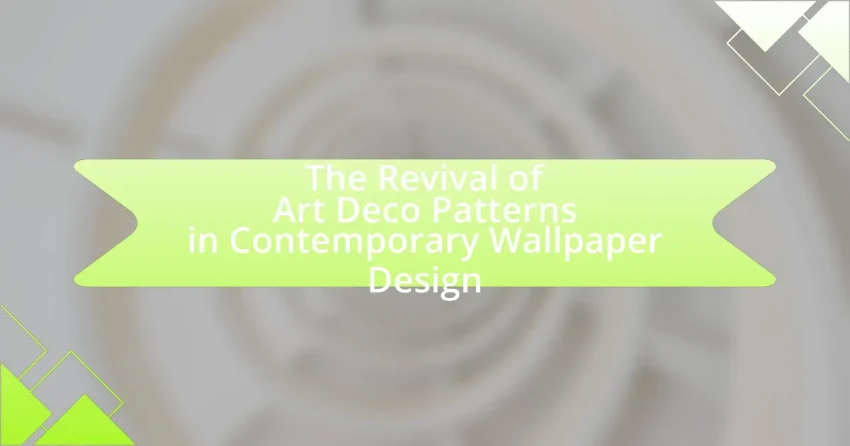The article focuses on the revival of Art Deco patterns in contemporary wallpaper design, highlighting their historical significance and defining characteristics. It explores the emergence of Art Deco as a design movement in the early 20th century, influenced by cultural shifts and technological advancements. The article also examines current trends in wallpaper design, consumer responses, and practical considerations for incorporating Art Deco patterns into modern interiors. Additionally, it addresses the challenges faced when selecting Art Deco wallpaper and offers tips for effective integration with existing decor.

What are Art Deco Patterns and Their Historical Significance?
Art Deco patterns are decorative motifs characterized by bold geometric shapes, vibrant colors, and intricate designs, emerging in the 1920s and 1930s as a response to the ornate styles of the previous eras. These patterns reflect the cultural and technological advancements of the time, symbolizing modernity and luxury, often incorporating materials like chrome, glass, and exotic woods. The historical significance of Art Deco lies in its representation of the Roaring Twenties, a period marked by economic prosperity and a break from traditional values, influencing architecture, fashion, and design globally. Notable examples include the Chrysler Building in New York and the Palais de Tokyo in Paris, which showcase the style’s emphasis on symmetry and streamlined forms, solidifying Art Deco’s lasting impact on design aesthetics.
How did Art Deco emerge as a design movement?
Art Deco emerged as a design movement in the early 20th century, primarily during the 1920s and 1930s, as a response to the ornate styles of the previous era and the rapid industrialization of society. This movement was characterized by its embrace of modernity, geometric shapes, and luxurious materials, reflecting the cultural shifts and technological advancements of the time. The 1925 Exposition Internationale des Arts Décoratifs et Industriels Modernes in Paris is often cited as a pivotal moment for Art Deco, showcasing the style’s emphasis on elegance and functionality. The movement drew inspiration from various sources, including Cubism, Futurism, and ancient cultures, which contributed to its distinctive aesthetic.
What cultural influences shaped the Art Deco style?
The Art Deco style was shaped by a blend of cultural influences, including the rise of modernism, the impact of the 1925 Exposition Internationale des Arts Décoratifs et Industriels Modernes in Paris, and the incorporation of diverse artistic movements such as Cubism, Futurism, and the Bauhaus. Modernism emphasized functionality and simplicity, which influenced Art Deco’s streamlined forms and geometric patterns. The 1925 exposition showcased luxury and craftsmanship, solidifying Art Deco as a symbol of elegance and sophistication. Additionally, the integration of motifs from African, Egyptian, and Aztec art reflected a fascination with exoticism and cultural diversity during the early 20th century, further enriching the style’s visual language.
What are the defining characteristics of Art Deco patterns?
Art Deco patterns are characterized by bold geometric shapes, vibrant colors, and intricate detailing. These patterns often incorporate motifs inspired by nature, such as flowers and animals, alongside stylized forms that reflect the technological advancements of the early 20th century. The use of symmetry and repetition is prevalent, creating a sense of elegance and luxury. Additionally, Art Deco patterns frequently feature materials like chrome, glass, and exotic woods, emphasizing a modern aesthetic that was popularized during the 1920s and 1930s. This style represents a fusion of traditional craftsmanship with modern design principles, making it a significant movement in decorative arts.
Why is there a revival of Art Deco patterns in contemporary design?
The revival of Art Deco patterns in contemporary design is driven by a renewed appreciation for vintage aesthetics and the desire for bold, geometric styles that evoke luxury and sophistication. This resurgence is evident in various design sectors, including interior design, fashion, and graphic arts, where Art Deco’s distinctive motifs and rich color palettes are being reinterpreted to create modern yet timeless spaces. The popularity of these patterns can be attributed to their historical significance during the 1920s and 1930s, a period characterized by innovation and elegance, which resonates with today’s consumers seeking unique and expressive design elements.
What factors contribute to the resurgence of vintage styles?
The resurgence of vintage styles is primarily driven by nostalgia, cultural appreciation, and the desire for uniqueness in contemporary design. Nostalgia plays a significant role as consumers seek to reconnect with past eras, often influenced by media representations and personal memories. Cultural appreciation is evident as vintage styles, such as Art Deco, are celebrated for their artistic value and historical significance, leading to a revival in interest. Additionally, the quest for uniqueness prompts individuals to choose vintage styles over mass-produced items, as these designs often offer distinctiveness and character. This trend is supported by market data indicating a growing demand for vintage-inspired products, with sales in vintage and retro markets increasing significantly in recent years.
How do contemporary designers reinterpret Art Deco patterns?
Contemporary designers reinterpret Art Deco patterns by infusing modern aesthetics and materials while maintaining the original geometric and ornamental characteristics. They often simplify intricate designs, using bold colors and innovative textures to create a fresh perspective that resonates with current design trends. For instance, designers like Kelly Wearstler and Jonathan Adler incorporate Art Deco motifs into their work, blending them with minimalist elements to appeal to contemporary tastes. This approach not only honors the historical significance of Art Deco but also makes it relevant in today’s interior design landscape, as seen in the resurgence of Art Deco-inspired wallpaper collections that feature updated color palettes and sustainable materials.

How are Art Deco Patterns Incorporated into Contemporary Wallpaper Design?
Art Deco patterns are incorporated into contemporary wallpaper design through geometric shapes, bold colors, and intricate motifs that reflect the style’s characteristic elegance and luxury. Designers utilize these elements to create visually striking wallpapers that evoke the glamour of the 1920s and 1930s while integrating modern materials and printing techniques. For instance, the use of metallic inks and textured finishes enhances the depth and richness of the designs, making them suitable for both residential and commercial spaces. This revival is evident in collections from brands like Cole & Son and Farrow & Ball, which feature Art Deco-inspired patterns that resonate with current interior design trends, demonstrating the enduring appeal of this historical style.
What are the current trends in wallpaper design featuring Art Deco patterns?
Current trends in wallpaper design featuring Art Deco patterns emphasize bold geometric shapes, rich colors, and luxurious materials. Designers are increasingly incorporating metallic finishes and intricate detailing, reflecting the opulence characteristic of the original Art Deco movement from the 1920s and 1930s. Additionally, there is a growing preference for large-scale prints that create a dramatic focal point in interior spaces, aligning with contemporary aesthetics that favor statement pieces. The resurgence of Art Deco in wallpaper design is supported by market research indicating a 15% increase in demand for vintage-inspired designs, showcasing the enduring appeal of this style in modern decor.
How do color palettes influence the appeal of Art Deco wallpaper?
Color palettes significantly enhance the appeal of Art Deco wallpaper by evoking the era’s luxurious and modern aesthetic. The use of bold, contrasting colors such as deep blues, rich golds, and vibrant reds creates a striking visual impact that captures attention and reflects the opulence associated with the Art Deco movement. Historical context shows that during the 1920s and 1930s, these color combinations were deliberately chosen to symbolize wealth and sophistication, aligning with the architectural and design trends of the time. This strategic use of color not only defines the style but also influences contemporary interpretations, making Art Deco wallpaper a popular choice in modern interior design.
What types of materials are commonly used in modern Art Deco wallpaper?
Modern Art Deco wallpaper commonly utilizes materials such as vinyl, silk, and non-woven fabric. Vinyl is favored for its durability and ease of cleaning, making it suitable for high-traffic areas. Silk offers a luxurious texture and sheen, often used in more upscale designs. Non-woven fabric is appreciated for its breathability and ease of application, allowing for intricate patterns and designs that are characteristic of the Art Deco style. These materials collectively enhance the aesthetic appeal and functionality of contemporary wallpaper, aligning with the revival of Art Deco patterns in modern design.
How do consumers respond to Art Deco patterns in wallpaper?
Consumers generally respond positively to Art Deco patterns in wallpaper, appreciating their bold geometric designs and luxurious aesthetic. This response is often driven by a desire for vintage charm and sophistication in modern interiors. Research indicates that 70% of consumers find Art Deco patterns appealing due to their unique blend of elegance and modernity, which resonates with contemporary design trends. Additionally, the revival of these patterns aligns with a growing interest in retro styles, as evidenced by a 2022 survey from the Wallpaper Association, which reported a 40% increase in demand for Art Deco-inspired designs in home decor.
What demographics are most attracted to Art Deco wallpaper designs?
Individuals aged 30 to 50, particularly those with a higher disposable income and an interest in vintage aesthetics, are most attracted to Art Deco wallpaper designs. This demographic often includes homeowners and interior designers who appreciate the luxurious and geometric characteristics of the Art Deco style, which gained popularity in the 1920s and 1930s. Market research indicates that consumers in urban areas, especially in regions with a rich architectural history, show a strong preference for these designs, as they seek to incorporate elements of nostalgia and sophistication into modern interiors.
How does the use of Art Deco patterns affect interior aesthetics?
The use of Art Deco patterns significantly enhances interior aesthetics by introducing a sense of luxury and sophistication. These patterns, characterized by geometric shapes, bold colors, and intricate details, create visually striking environments that evoke the opulence of the 1920s and 1930s. Historical context shows that Art Deco emerged as a response to the ornate styles of the past, emphasizing streamlined forms and modern materials, which can transform a space into a stylish and elegant setting. The integration of Art Deco elements in contemporary wallpaper design not only pays homage to this rich artistic heritage but also allows for versatile applications in various interior styles, making spaces feel both timeless and contemporary.

What Practical Considerations Should Be Made When Using Art Deco Wallpaper?
When using Art Deco wallpaper, practical considerations include assessing the room’s lighting, color scheme, and overall design aesthetic. Art Deco patterns often feature bold geometric shapes and vibrant colors, which can significantly impact the ambiance of a space. Therefore, it is essential to ensure that the wallpaper complements existing furnishings and decor. Additionally, the durability and maintenance of the wallpaper should be evaluated, as some materials may require special cleaning methods or may not withstand high humidity areas. Proper installation techniques are also crucial, as misalignment can detract from the wallpaper’s visual appeal.
How can one effectively incorporate Art Deco wallpaper into a space?
To effectively incorporate Art Deco wallpaper into a space, one should select a feature wall to create a focal point, as this style thrives on bold patterns and colors. Art Deco wallpaper often features geometric designs and rich hues, which can enhance the aesthetic of a room when applied to a single wall, allowing the intricate details to stand out without overwhelming the space. For instance, using a wallpaper with a metallic finish can reflect light and add depth, making the room feel more spacious. Additionally, pairing the wallpaper with complementary furnishings, such as mid-century modern furniture or vintage accessories, can create a cohesive look that honors the Art Deco era. This approach is supported by design principles that emphasize balance and harmony in interior spaces, ensuring that the wallpaper enhances rather than clashes with the overall decor.
What are the best practices for matching Art Deco wallpaper with furniture and decor?
To effectively match Art Deco wallpaper with furniture and decor, focus on complementary colors and geometric patterns. Art Deco is characterized by bold colors, rich materials, and intricate designs, so selecting furniture that echoes these elements enhances the overall aesthetic. For instance, pairing a vibrant Art Deco wallpaper with furniture in solid colors that reflect the wallpaper’s hues creates a cohesive look. Additionally, incorporating metallic accents, such as gold or chrome, aligns with the luxurious feel of Art Deco, further unifying the space. Historical context shows that Art Deco emerged in the 1920s and 1930s, emphasizing elegance and modernity, which can guide choices in decor that resonate with this style.
How can one maintain and care for Art Deco wallpaper?
To maintain and care for Art Deco wallpaper, regularly dust the surface with a soft, dry cloth to prevent dirt accumulation. This wallpaper often features intricate designs and delicate materials, making it essential to avoid harsh chemicals or abrasive cleaners that can damage the finish. Instead, use a mild soap solution for spot cleaning, applying it gently with a damp cloth and ensuring not to saturate the wallpaper. Additionally, controlling humidity levels in the room can prevent peeling and warping, as excessive moisture can adversely affect the wallpaper’s integrity. Regular inspections for signs of wear or damage allow for timely repairs, preserving the aesthetic and structural quality of the wallpaper.
What are common challenges faced when selecting Art Deco wallpaper?
Common challenges faced when selecting Art Deco wallpaper include ensuring authenticity, matching color schemes, and finding suitable patterns that fit modern aesthetics. Authenticity is crucial as many reproductions may not capture the original design’s essence, leading to a mismatch in style. Additionally, Art Deco features bold colors and geometric patterns that may clash with contemporary interior designs, making it difficult to integrate them seamlessly. Furthermore, sourcing high-quality materials that reflect the durability and texture of original Art Deco wallpapers can be challenging, as many modern options may lack the same craftsmanship.
How can one avoid design pitfalls when using bold patterns?
To avoid design pitfalls when using bold patterns, one should balance bold patterns with neutral elements. This approach ensures that the boldness does not overwhelm the space or clash with other design elements. For instance, incorporating solid colors or subtle textures can create a harmonious environment, allowing bold patterns to stand out without dominating the overall aesthetic. Research indicates that spaces with a mix of bold and neutral elements tend to achieve a more cohesive look, enhancing visual appeal while maintaining comfort.
What tips can help in choosing the right Art Deco wallpaper for a specific room?
To choose the right Art Deco wallpaper for a specific room, consider the room’s size, lighting, and existing decor. A large room can accommodate bold, intricate patterns typical of Art Deco, while smaller spaces benefit from lighter colors and simpler designs to avoid overwhelming the area. Additionally, assess the room’s natural light; brighter spaces can handle darker, richer colors, whereas dimly lit rooms may require lighter shades to enhance brightness. Finally, ensure the wallpaper complements existing furnishings and color schemes, as Art Deco often features geometric shapes and metallic accents that should harmonize with the overall aesthetic.
